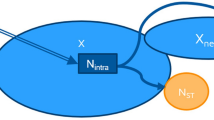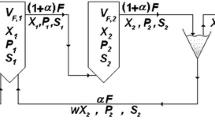Abstract
Nitrogen has a strong impact on the key bio-mechanisms involved during the grape-must fermentation but also on the synthesis of flavour markers determining the aromatic profile of the wine. This paper first presents a consistent dynamical mass balance model describing the main physiological phenomena implied in standard batch fermentations, i.e. consumption of sugar and nitrogen and synthesis of ethanol. It also includes nitrogen compounds such as hexose transporters. Moreover, a common practice in wine-making is the addition of nitrogen during the fermentation in order to boost and shorten the process duration. A tractable representation of this boost effect has therefore been developed as an extension of the first model. It is apparent that yeast makes a different use of nitrogen depending on the fermentation stage at which the addition is effected, balancing the regrowth of biomass and the synthesis of supplementary hexose transporters. These models have been validated in line with experimental evidence deduced from extensive experimental studies.



















Similar content being viewed by others
Notes
More information can be found on http://www.cafe-project.org.
References
Bruin S, Jongen TRG (2003) Food process engineering: the last 25 years and challenges ahead. Compr Rev Food Sci Technol 2:42–81
Bastin G, Dochain D (1990) On-line estimation and adaptive control of bioreactors. Elsevier, Amsterdam
David R, Dochain D, Mouret JR, Vande Wouwer A, Sablayrolles JM (2010) Dynamical modeling of alcoholic fermentation and its link with nitrogen consumption. In: Proceedings of the 11th international symposium on computer applications in biotechnology (CAB 2010). Leuven, Belgium, pp. 496–501
Boulton R (1980) The prediction of fermentation behavior by a kinetic model. Am J Enol Vitic 31(1):40–45
Sevely Y, Pourciel JP, Rauzy G, Bovee JP (1981) Modelling, identification and control of the alcohol fermentation in a cascade reactor. In: Proceedings of 8th IFAC World Congress, Kyoto, Japan, pp. 177–184
Williams D, Yousefpour P, Wellington EM (1986) On-line adaptive control of a fed-batch fermentation of Saccharomyces cerevisiae. Biotechnol Bioeng 28:631–645
Caro I, Perez L, Cantero D (1991) Development of a kinetic model for the alcoholic fermentation of must. Biotechnol Bioeng 38:742–748
Remedios Marín M (1999) Alcoholic fermentation modelling: current state and perspectives. Am J Enol Vitic 50(2):166–178
Cramer AC, Vlassides S, Block DE (2002) Kinetic model for nitrogen-limited wine fermentations. Biotechnol Bioeng 77(1):49–60
Coleman MC, Fish R, Block DE (2007) Temperature-dependent kinetic model for nitrogen-limited wine fermentations. Appl Environ Microbiol 73(18):5875–5884
Malherbe S, Fromion V, Hilgert N, Sablayrolles JM (2004) Modeling the effects of assimilable nitrogen and temperature on fermentation kinetics in enological conditions. Biotechnol Bioeng 86(3):261–272
Sonnleitner B, Käppeli O (1986) Growth of Saccharomyces cerevisiae is controlled by its limited respiratory capacity: formulation and verification of a hypothesis. Biotechnol Bioeng 28(6):927–937
Leão C, van Uden N (1982) Effects of ethanol and other alkanols on the glucose transport system of Saccharomyces cerevisiae. Biotechnol Bioeng 24(11):2601–2604
Leão C, van Uden N (1983) Effects of ethanol and other alkanols on the ammonium transport system of Saccharomyces cerevisiae. Biotechnol Bioeng 25(8):2085–2089
Salmon J, Vincent O, Mauricio J, Bely M, Barre P (1993) Sugar transport inhibition and apparent loss of activity in Saccharomyces cerevisiae as a major limiting factor of enological fermentations. Am J Enol Vitic 44:56–64
Malherbe S (2003) Modélisation de la fermentation alcoolique en conditions oenologiques. Ph.D. thesis. Université de Montpellier II, France
Bely M, Sablayrolles JM, Barre P (1990) Automatic detection of assimilable nitrogen deficiencies during alcoholic fermentation in oenological conditions. J Ferment Bioeng 70(4):246–252
Slaughter JC, Smith JP, Mitchell WJ (1991) Glucose transport throughout fermentation by Saccharomyces cerevisiae ncyc 1108. Lett Appl Microbiol 12(6):221–223
David R, Dochain D, Mouret JR, Vande Wouwer A, Sablayrolles JM (2011) Modeling of the aromatic profile in wine-making fermentation: the backbone equations. In: Proceedings of the 18th IFAC World Congress, Milano, pp. 10597–10602
Jones DB (1941) Factors for converting percentages of nitrogen in foods and feeds into percentages of protein. US Deptartment of Agricultural, Circular 183, Washington
El Haloui NE, Corrieu G, Cleran Y, Cheruy A (1989) Method for on-line prediction of kinetics of alcoholic fermentation in wine making. J Ferment Bioeng 68(2):131–135
Casalta E, Aguera E, Picou C, Rodriguez-Bencomo JJ, Salmon JM, Sablayrolles JM (2010) A comparison of laboratory and pilot-scale fermentations in winemaking conditions. Appl Microbiol Biotechnol 87(5):1665–1673
Clément T, Perez M, Mouret JR, Sablayrolles JM, Camarasa C (2011) Use of a continuous multistage bioreactor to mimic winemaking fermentation. Int J Food Microbiol 150:42–49
Acknowledgments
This paper includes results of the CAFÉ project that is supported by the Food, Agriculture and Fisheries, and Biotechnology program of the European Community (Contract Number KBBE-212754). It also presents research results of the Belgian Programme on Interuniversity Poles of Attraction initiated by the Belgian State, Prime Minister’s Office, Science, Technology and Culture. The scientific responsibility rests with its authors.
Author information
Authors and Affiliations
Corresponding authors
Additional information
D. Dochain is a Honorary Research Director FNRS, Belgium.
Rights and permissions
About this article
Cite this article
David, R., Dochain, D., Mouret, JR. et al. Nitrogen-backboned modeling of wine-making in standard and nitrogen-added fermentations. Bioprocess Biosyst Eng 37, 5–16 (2014). https://doi.org/10.1007/s00449-013-0914-6
Received:
Accepted:
Published:
Issue Date:
DOI: https://doi.org/10.1007/s00449-013-0914-6




